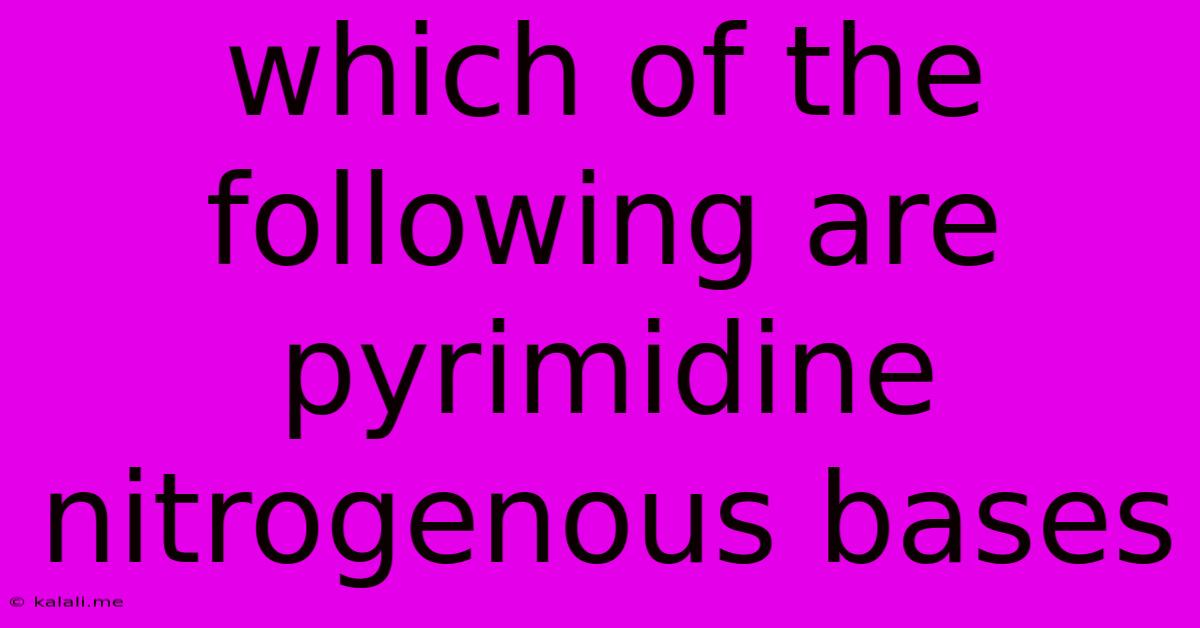Which Of The Following Are Pyrimidine Nitrogenous Bases
Kalali
Jun 15, 2025 · 2 min read

Table of Contents
Which of the Following Are Pyrimidine Nitrogenous Bases? Understanding DNA and RNA Building Blocks
Understanding the fundamental building blocks of DNA and RNA is crucial for grasping the complexities of genetics and molecular biology. This article will clarify which nitrogenous bases are classified as pyrimidines, explaining their structure and role within nucleic acids. We'll also explore the key differences between pyrimidines and purines.
Pyrimidine bases are a vital component of DNA and RNA, forming one of the two categories of nitrogenous bases. The other category is purines. Knowing which bases fall under each category is fundamental to understanding the structure and function of nucleic acids.
What are Pyrimidine Bases?
Pyrimidines are a type of aromatic heterocyclic organic compound with a six-membered ring containing two nitrogen atoms. In the context of nucleic acids, the pyrimidine bases are cytosine (C), thymine (T), and uracil (U). These bases form hydrogen bonds with purine bases (adenine and guanine) to create the characteristic double helix structure of DNA and the single-stranded structure of RNA.
-
Cytosine (C): Found in both DNA and RNA, cytosine pairs with guanine through three hydrogen bonds. Its presence is crucial for the stability of the DNA double helix.
-
Thymine (T): Found exclusively in DNA, thymine pairs with adenine through two hydrogen bonds. Its methyl group distinguishes it from uracil.
-
Uracil (U): Found exclusively in RNA, uracil pairs with adenine through two hydrogen bonds. It replaces thymine in RNA molecules.
Pyrimidines vs. Purines: Key Differences
The key difference between pyrimidines and purines lies in their structure:
-
Pyrimidines: Have a single six-membered ring structure.
-
Purines: Have a double-ring structure consisting of a six-membered ring fused to a five-membered ring. The purine bases are adenine (A) and guanine (G).
This structural difference directly impacts their ability to form hydrogen bonds with their complementary bases, which is essential for the accurate replication and transcription of genetic information.
Identifying Pyrimidine Bases in a Given Set
To determine whether a nitrogenous base is a pyrimidine, simply remember the three letters: C, T, and U. Any other nitrogenous base will be a purine. For example, if you are presented with a list containing adenine (A), guanine (G), cytosine (C), thymine (T), and uracil (U), you would correctly identify cytosine, thymine, and uracil as the pyrimidine bases.
Understanding the distinction between pyrimidines and purines is critical for comprehending the fundamental principles of molecular biology and genetics. Their specific structures and interactions are essential for the accurate storage and transmission of genetic information within living organisms. The precise pairing of pyrimidines and purines ensures the integrity of the genetic code.
Latest Posts
Latest Posts
-
What Is The Factor Of 74
Jun 16, 2025
-
What Is The Square Root Of 1225
Jun 16, 2025
-
Device Used To Change Ac To Dc
Jun 16, 2025
-
Admission Requirements For West Chester University
Jun 16, 2025
-
Which Of The Following Is Not An Element Of Tqm
Jun 16, 2025
Related Post
Thank you for visiting our website which covers about Which Of The Following Are Pyrimidine Nitrogenous Bases . We hope the information provided has been useful to you. Feel free to contact us if you have any questions or need further assistance. See you next time and don't miss to bookmark.